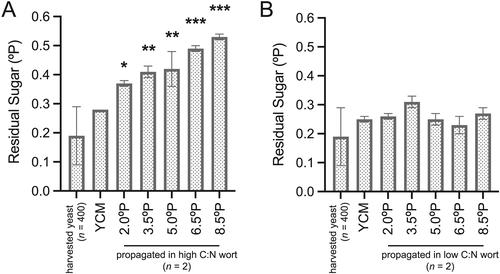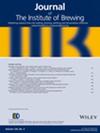下载PDF
{"title":"酵母繁殖过程中呼吸-发酵平衡对发酵和麦汁衰减的影响","authors":"Maria E. Moutsoglou, Ashley C. Dearden","doi":"10.1002/jib.621","DOIUrl":null,"url":null,"abstract":"<p>Breweries use different yeast strains to create beers with different flavours and aromas. Yeast propagation must produce yeast that performs consistently from the first fermentation to harvesting and re-pitching in subsequent fermentations. Breweries propagate yeast in wort leading to low efficiency fermentative growth in Crabtree-positive yeast. There is limited knowledge on the impact on beer production when fermenting with yeast propagated in sugar limited and nutrient supplemented wort. It was hypothesised that propagating yeast in this way would have a positive impact on subsequent fermentation performance. <i>Saccharomyces cerevisiae</i> was propagated at the laboratory scale in standard wort with a high carbon to nitrogen (C:N) ratio (850) or in modified wort supplemented with yeast extract to achieve a low C:N ratio (100) and at varying sugar concentrations. Propagation in low C:N wort with 2°P sugar yielded a 27% decrease in fermentation efficiency and a 46% increase in cell production compared to 2°P high C:N wort. This suggests nitrogen is critical to the respiro-fermentative balance during growth. Yeast propagated in standard wort resulted in slower fermentations and significant under-attenuation compared to yeast grown in the modified wort with low sugar and high nitrogen. The results of this study suggest the nitrogen and sugar content drive the respiro-fermentative balance during yeast propagation. The metabolism of yeast during propagation induces significant downstream impacts on the subsequent fermentation performance and wort attenuation. © 2020 The Institute of Brewing & Distilling</p>","PeriodicalId":17279,"journal":{"name":"Journal of The Institute of Brewing","volume":null,"pages":null},"PeriodicalIF":2.4000,"publicationDate":"2020-07-29","publicationTypes":"Journal Article","fieldsOfStudy":null,"isOpenAccess":false,"openAccessPdf":"https://sci-hub-pdf.com/10.1002/jib.621","citationCount":"4","resultStr":"{\"title\":\"Effect of the respiro-fermentative balance during yeast propagation on fermentation and wort attenuation\",\"authors\":\"Maria E. Moutsoglou, Ashley C. Dearden\",\"doi\":\"10.1002/jib.621\",\"DOIUrl\":null,\"url\":null,\"abstract\":\"<p>Breweries use different yeast strains to create beers with different flavours and aromas. Yeast propagation must produce yeast that performs consistently from the first fermentation to harvesting and re-pitching in subsequent fermentations. Breweries propagate yeast in wort leading to low efficiency fermentative growth in Crabtree-positive yeast. There is limited knowledge on the impact on beer production when fermenting with yeast propagated in sugar limited and nutrient supplemented wort. It was hypothesised that propagating yeast in this way would have a positive impact on subsequent fermentation performance. <i>Saccharomyces cerevisiae</i> was propagated at the laboratory scale in standard wort with a high carbon to nitrogen (C:N) ratio (850) or in modified wort supplemented with yeast extract to achieve a low C:N ratio (100) and at varying sugar concentrations. Propagation in low C:N wort with 2°P sugar yielded a 27% decrease in fermentation efficiency and a 46% increase in cell production compared to 2°P high C:N wort. This suggests nitrogen is critical to the respiro-fermentative balance during growth. Yeast propagated in standard wort resulted in slower fermentations and significant under-attenuation compared to yeast grown in the modified wort with low sugar and high nitrogen. The results of this study suggest the nitrogen and sugar content drive the respiro-fermentative balance during yeast propagation. The metabolism of yeast during propagation induces significant downstream impacts on the subsequent fermentation performance and wort attenuation. © 2020 The Institute of Brewing & Distilling</p>\",\"PeriodicalId\":17279,\"journal\":{\"name\":\"Journal of The Institute of Brewing\",\"volume\":null,\"pages\":null},\"PeriodicalIF\":2.4000,\"publicationDate\":\"2020-07-29\",\"publicationTypes\":\"Journal Article\",\"fieldsOfStudy\":null,\"isOpenAccess\":false,\"openAccessPdf\":\"https://sci-hub-pdf.com/10.1002/jib.621\",\"citationCount\":\"4\",\"resultStr\":null,\"platform\":\"Semanticscholar\",\"paperid\":null,\"PeriodicalName\":\"Journal of The Institute of Brewing\",\"FirstCategoryId\":\"97\",\"ListUrlMain\":\"https://onlinelibrary.wiley.com/doi/10.1002/jib.621\",\"RegionNum\":3,\"RegionCategory\":\"农林科学\",\"ArticlePicture\":[],\"TitleCN\":null,\"AbstractTextCN\":null,\"PMCID\":null,\"EPubDate\":\"\",\"PubModel\":\"\",\"JCR\":\"Q3\",\"JCRName\":\"FOOD SCIENCE & TECHNOLOGY\",\"Score\":null,\"Total\":0}","platform":"Semanticscholar","paperid":null,"PeriodicalName":"Journal of The Institute of Brewing","FirstCategoryId":"97","ListUrlMain":"https://onlinelibrary.wiley.com/doi/10.1002/jib.621","RegionNum":3,"RegionCategory":"农林科学","ArticlePicture":[],"TitleCN":null,"AbstractTextCN":null,"PMCID":null,"EPubDate":"","PubModel":"","JCR":"Q3","JCRName":"FOOD SCIENCE & TECHNOLOGY","Score":null,"Total":0}
引用次数: 4
引用
批量引用



